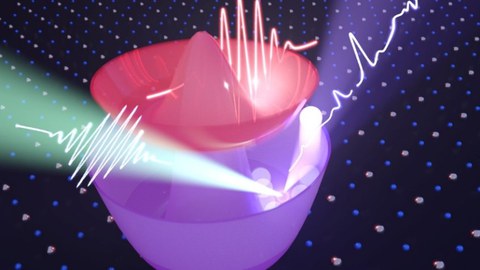Aug 11, 2025
Research: Novel Experimental Method Measures the Higgs Mode in High-Temperature Superconductors

A NEARS measurement on the superconductor characterizes its Higgs mode like a fingerprint. To do this, the Higgs mode is excited into oscillation by a quench pulse (red). These oscillations can then be fully characterized in different symmetry channels via anti-Stokes Raman scattering (blue).
An international research team including Tomke Glier (University of Hamburg), Stefan Kaiser (TU Dresden), Dirk Manske (Max Planck Institute for Solid State Research, Stuttgart), and Michael Rübhausen (University of Hamburg) has developed a groundbreaking experimental method to directly measure the Higgs mode in superconductors.
In superconductors, electrons can pair up in a remarkable way: they move collectively in a shared quantum state in which electric current flows without any resistance. Researchers can selectively excite this state using ultrashort laser pulses, setting it into oscillation. This process gives rise to so-called Higgs modes — collective oscillations of the superconducting state itself.
The term "Higgs modes" is no coincidence: it evokes the famous Higgs boson from particle physics, as both phenomena involve the oscillation of a field, governed by the same physical principle of symmetry breaking. In superconductors, the Higgs mode offers valuable insight into the hidden symmetries and internal structure of this extraordinary state. One can think of the vibrational spectrum of the Higgs modes as the fingerprint of a superconductor — a kind of characteristic echo that reveals its properties.
The newly developed spectroscopic method now enables researchers to directly and selectively observe Higgs modes. "Terahertz lasers have enabled significant advances in experimental Higgs spectroscopy over the past decade," explains Stefan Kaiser, Professor at TU Dresden. "What has been lacking, however, is a precise tool for probing the symmetry properties of these excitations — this is precisely where Raman spectroscopy comes into play."
To that end, the team developed Non-Equilibrium Anti-Stokes Raman Scattering (NEARS). The method involves initiating a controlled “soft quench” of the so-called Mexican hat potential, which leads to the targeted excitation of metastable Higgs states. "This excitation induces a characteristic population inversion, which manifests in the spectrum as an additional anti-Stokes Raman signal," explains Tomke Glier, first author of the study. "This polarization-dependent Raman spectroscopy enables, for the first time, the experimental determination of the symmetry of Higgs modes.
NEARS opens up a systematic approach for analyzing amplitude modes across a wide range of quantum condensates — from superconductors with competing orders to transiently induced superconducting states or interface superconductors. In the future, the presence of the Higgs mode may even serve as a criterion for identifying superconductivity and be used to characterize coherence lengths and order parameter symmetries in new superconductors.
T. E. Glier, S. Tian, M. Rerrer, L. Westphlas, G. Lüllau, L. Feng, J. Dolgner, R. Haenel, M. Zonno, H. Eisaki, M. Greven, A. Damascelli, S. Kaiser, D. Manske, M. Rübhausen,
Non-equilibrium anti-Stokes Raman spectroscopy for investigating Higgs modes in superconductors,
Nat. Commun. 16, 7027 (2025)
